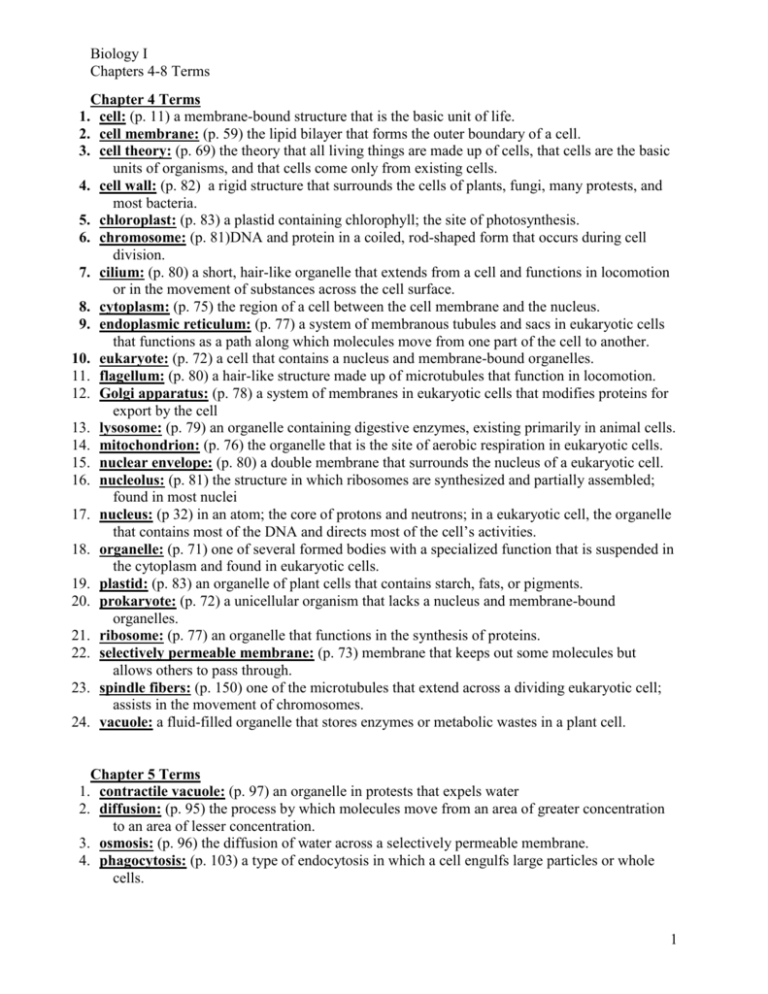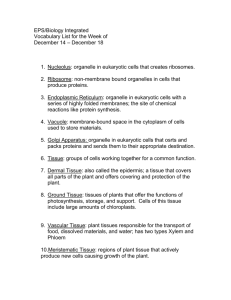Chapters 4-8 Terms
advertisement

Biology I Chapters 4-8 Terms Chapter 4 Terms 1. cell: (p. 11) a membrane-bound structure that is the basic unit of life. 2. cell membrane: (p. 59) the lipid bilayer that forms the outer boundary of a cell. 3. cell theory: (p. 69) the theory that all living things are made up of cells, that cells are the basic units of organisms, and that cells come only from existing cells. 4. cell wall: (p. 82) a rigid structure that surrounds the cells of plants, fungi, many protests, and most bacteria. 5. chloroplast: (p. 83) a plastid containing chlorophyll; the site of photosynthesis. 6. chromosome: (p. 81)DNA and protein in a coiled, rod-shaped form that occurs during cell division. 7. cilium: (p. 80) a short, hair-like organelle that extends from a cell and functions in locomotion or in the movement of substances across the cell surface. 8. cytoplasm: (p. 75) the region of a cell between the cell membrane and the nucleus. 9. endoplasmic reticulum: (p. 77) a system of membranous tubules and sacs in eukaryotic cells that functions as a path along which molecules move from one part of the cell to another. 10. eukaryote: (p. 72) a cell that contains a nucleus and membrane-bound organelles. 11. flagellum: (p. 80) a hair-like structure made up of microtubules that function in locomotion. 12. Golgi apparatus: (p. 78) a system of membranes in eukaryotic cells that modifies proteins for export by the cell 13. lysosome: (p. 79) an organelle containing digestive enzymes, existing primarily in animal cells. 14. mitochondrion: (p. 76) the organelle that is the site of aerobic respiration in eukaryotic cells. 15. nuclear envelope: (p. 80) a double membrane that surrounds the nucleus of a eukaryotic cell. 16. nucleolus: (p. 81) the structure in which ribosomes are synthesized and partially assembled; found in most nuclei 17. nucleus: (p 32) in an atom; the core of protons and neutrons; in a eukaryotic cell, the organelle that contains most of the DNA and directs most of the cell’s activities. 18. organelle: (p. 71) one of several formed bodies with a specialized function that is suspended in the cytoplasm and found in eukaryotic cells. 19. plastid: (p. 83) an organelle of plant cells that contains starch, fats, or pigments. 20. prokaryote: (p. 72) a unicellular organism that lacks a nucleus and membrane-bound organelles. 21. ribosome: (p. 77) an organelle that functions in the synthesis of proteins. 22. selectively permeable membrane: (p. 73) membrane that keeps out some molecules but allows others to pass through. 23. spindle fibers: (p. 150) one of the microtubules that extend across a dividing eukaryotic cell; assists in the movement of chromosomes. 24. vacuole: a fluid-filled organelle that stores enzymes or metabolic wastes in a plant cell. Chapter 5 Terms 1. contractile vacuole: (p. 97) an organelle in protests that expels water 2. diffusion: (p. 95) the process by which molecules move from an area of greater concentration to an area of lesser concentration. 3. osmosis: (p. 96) the diffusion of water across a selectively permeable membrane. 4. phagocytosis: (p. 103) a type of endocytosis in which a cell engulfs large particles or whole cells. 1 Biology I Chapters 4-8 Terms 5. pinocytosis: (p. 103) a type of endocytosis in which a cell engulfs solutes or fluids. 6. turgor pressure: (p 98) water pressure within a plant cell. Chapter 6 Terms 1. adenosine diphosphate (ADP): (p. 116) a substance involved in energy metabolism formed by the breakdown of adenosine triphosphate. 2. ATP synthase: (p. 116) an enzyme that catalyzes the synthesis of ATP from ADP and phosphate. 3. carotenoid: (p. 113) a light-absorbing compound that functions as an accessory pigment in photosynthesis 4. light reactions: (p. 112) the initial reactions in photosynthesis, including the absorption of light by photosystems I and II, the passage of electrons along the electron transport chains, the production of NADPH and O2, and the synthesis of ATP through chemiosmosis. 5. photosynthesis: (p. 111) the conversion of light energy into chemical energy stored in organic compounds. 6. pigment: (p. 112) in plants, a compound that absorbs light and imparts color. 7. stoma: (p. 119) one of many small pores usually located on the underside of a leaf; aids in gas exchange. Chapter 7 1. alcoholic fermentation: (p. 129) the process by which pyruvic acid is converted to ethyl alcohol; the anaerobic action of yeast on sugars. 2. anaerobic pathway: (p. 128) the fermentation pathways 3. cellular respiration: (p. 127) the process in which cells make ATP by breaking down organic compounds. 4. glycolysis: (p. 127) a pathway in which glucose is oxidized to pyruvic acid. 5. lactic acid fermentation: (p. 129) the process by which pyruvic acid is converted to lactic acid. 6. pyruvic acid: (p. 128) a three-carbon molecule that is the end product of glycolysis. 7. aerobic respiration: (p. 133) the process in which cells make ATP by breaking down organic compounds, with oxygen as the final electron acceptor. 8. Krebs cyle: (p. 133) a series of biochemical reactions that release carbon dioxide and results in the formation of ATP. Chapter 8 1. anaphase: (p. 150) a phase of mitosis and meiosis in which the chromosomes separate. 2. asexual reproduction: (p. 156) the production of offspring that does not involve the union of gametes. 3. cell plate: (p. 151) a membrane that divides newly forming plant cells following mitosis. 4. centriole: (p. 150) a structure that appears during mitosis in animal cells. 5. centromere: (p. 146) a region of the chromosome where the two sister chromatids are held together and which is the site of attachment of the chromosomes to the spindle fibers during mitosis. 6. chromatid: (p. 146) one of two identical parts of a chromosome. 7. crossing-over: (p. 153) the exchange of genes by reciprocal segments of homologous chromosomes during meiosis. 2 Biology I Chapters 4-8 Terms 8. 9. 10. 11. 12. 13. 14. 15. 16. 17. 18. cytokinesis: (p. 149) the division of the cytoplasm of one cell into two new cells. diploid: (p. 147) a cell that contains both chromosomes of a homologous pair. haploid: (p. 147) having only one chromosome of each homologous pair. homologous chromosome: (p. 146) one of a pair of morphologically similar chromosomes. interphase: (p. 149) a period of cell growth and development that precedes eukayotic cell nuclear division. meiosis: (p. 148) the process of nuclear division that reduces the number of chromosomes in a cell by half. metaphase: (p. 150) the second phase of mitosis, during which all the chromosomes move to cell’s equator mitosis: (p. 148) eukaryotic nuclear division prophase: (p. 150) the first stage of mitosis and meiosis, characterized by condensation of chromosomes. synapsis: (p. 153) the pairing of homologous chromosomes during meiosis. telophase: (p 151) the final stage of mitosis during which a nuclear membrane forms around each set of new chromosomes. 3








